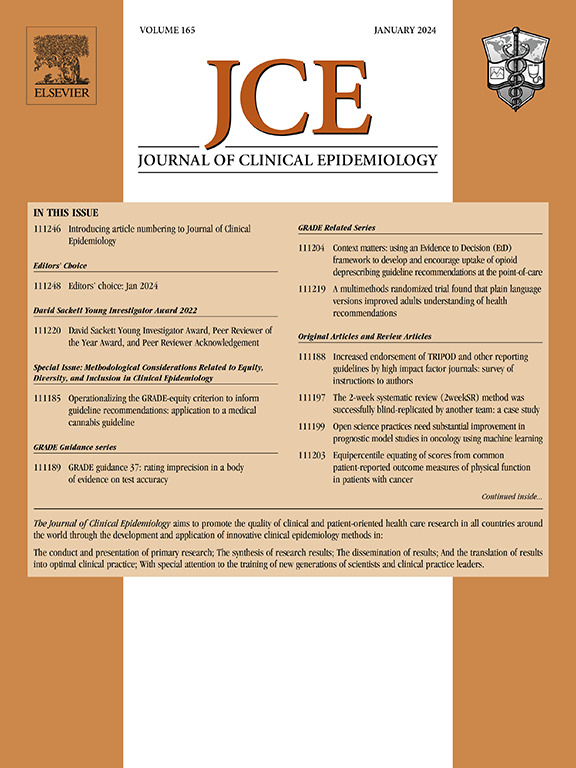Assessing the coverage of PubMed, Embase, OpenAlex, and Semantic Scholar for automated single-database searches in living guideline evidence surveillance: a case study of the international polycystic ovary syndrome guidelines 2023
IF 7.3
2区 医学
Q1 HEALTH CARE SCIENCES & SERVICES
引用次数: 0
Abstract
Objectives
Living guideline maintenance is underpinned by manual approaches toward evidence retrieval, limiting long-term sustainability. Our study aimed to evaluate the feasibility of using only PubMed, Embase, OpenAlex, or Semantic Scholar in automatically retrieving articles that were included in a high-quality international guideline - the 2023 international polycystic ovary syndrome (PCOS) guidelines.
Methods
The digital object identifiers (DOIs) and PubMed ID (PMIDs) of articles included after full-text screening in the 2023 international PCOS guidelines were extracted. These IDs were used to automatically retrieve article metadata from all tested databases. A title-only search was then conducted on articles that were not initially retrievable. The extent of coverage, and overlap of coverage, was determined for each database. An exploratory analysis of the risk of bias (RoB) of articles that were unretrievable was then conducted for each database.
Results
OpenAlex had the best coverage (98.6%), followed by Semantic Scholar (98.3%), Embase (96.8%), and PubMed (93.0%). However, 90.5% of all articles were retrievable from all four databases. All articles that were not retrievable from OpenAlex and Semantic Scholar were either assessed as medium or high RoB. In contrast, both Embase and PubMed missed articles that were of high quality (low RoB).
Conclusion
OpenAlex should be considered a single source for automated evidence retrieval in living guideline development, due to high coverage, and low risk of missing high-quality articles. These insights are being leveraged as part of transitioning the 2023 international PCOS guidelines toward a living format.
评估PubMed, Embase, OpenAlex和Semantic Scholar在生活指南证据监测中自动单数据库搜索的覆盖范围:国际多囊卵巢综合征指南2023的案例研究
目的:活体指南的维护以人工方法为基础,限制了长期的可持续性。本研究旨在评估仅使用PubMed、Embase、OpenAlex或Semantic Scholar自动检索高质量国际指南(2023年国际多囊卵巢综合征(PCOS)指南)中的文章的可行性。方法提取2023年国际PCOS指南全文筛选后纳入的文章的数字对象标识符(DOIs)和PubMed ID (pmid)。这些id用于从所有测试数据库中自动检索文章元数据。然后对最初无法检索的文章进行标题搜索。为每个数据库确定了覆盖范围和覆盖的重叠部分。然后对每个数据库进行不可检索文章的偏倚风险(RoB)的探索性分析。结果openalex的覆盖率最高(98.6%),其次是Semantic Scholar(98.3%)、Embase(96.8%)和PubMed(93.0%)。然而,90.5%的文章可以从所有四个数据库中检索到。所有无法从OpenAlex和Semantic Scholar中检索到的文章都被评估为中等或高RoB。相比之下,Embase和PubMed都遗漏了高质量(低RoB)的文章。结论openalex具有高覆盖率和低缺失风险,可作为生活指南制定中自动证据检索的单一来源。这些见解正在被用作2023年国际PCOS指南向生活形式过渡的一部分。
本文章由计算机程序翻译,如有差异,请以英文原文为准。
求助全文
约1分钟内获得全文
求助全文
来源期刊

Journal of Clinical Epidemiology
医学-公共卫生、环境卫生与职业卫生
CiteScore
12.00
自引率
6.90%
发文量
320
审稿时长
44 days
期刊介绍:
The Journal of Clinical Epidemiology strives to enhance the quality of clinical and patient-oriented healthcare research by advancing and applying innovative methods in conducting, presenting, synthesizing, disseminating, and translating research results into optimal clinical practice. Special emphasis is placed on training new generations of scientists and clinical practice leaders.
 求助内容:
求助内容: 应助结果提醒方式:
应助结果提醒方式:


